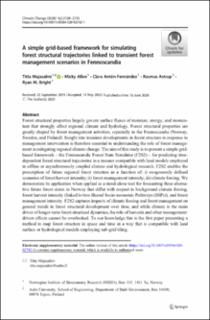| dc.contributor.author | Majasalmi, Titta | |
| dc.contributor.author | Allen, Micky | |
| dc.contributor.author | Antón-Fernández, Clara | |
| dc.contributor.author | Astrup, Rasmus Andreas | |
| dc.contributor.author | Bright, Ryan M. | |
| dc.date.accessioned | 2021-02-22T16:05:42Z | |
| dc.date.available | 2021-02-22T16:05:42Z | |
| dc.date.created | 2021-01-05T13:52:09Z | |
| dc.date.issued | 2020-06-16 | |
| dc.identifier.citation | Climatic Change. 2020, 162 2139-2155. | en_US |
| dc.identifier.issn | 0165-0009 | |
| dc.identifier.uri | https://hdl.handle.net/11250/2729605 | |
| dc.description.abstract | Forest structural properties largely govern surface fluxes of moisture, energy, and momentum that strongly affect regional climate and hydrology. Forest structural properties are greatly shaped by forest management activities, especially in the Fennoscandia (Norway, Sweden, and Finland). Insight into transient developments in forest structure in response to management intervention is therefore essential to understanding the role of forest management in mitigating regional climate change. The aim of this study is to present a simple grid-based framework – the Fennoscandic Forest State Simulator (F2S2) -- for predicting time-dependent forest structural trajectories in a manner compatible with land models employed in offline or asynchronously coupled climate and hydrological research. F2S2 enables the prescription of future regional forest structure as a function of: i) exogenously defined scenarios of forest harvest intensity; ii) forest management intensity; iii) climate forcing. We demonstrate its application when applied as a stand-alone tool for forecasting three alternative future forest states in Norway that differ with respect to background climate forcing, forest harvest intensity (linked to two Shared Socio-economic Pathways (SSPs)), and forest management intensity. F2S2 captures impacts of climate forcing and forest management on general trends in forest structural development over time, and while climate is the main driver of longer-term forest structural dynamics, the role of harvests and other management-driven effects cannot be overlooked. To our knowledge this is the first paper presenting a method to map forest structure in space and time in a way that is compatible with land surface or hydrological models employing sub-grid tiling. | en_US |
| dc.language.iso | eng | en_US |
| dc.publisher | Springer Nature | en_US |
| dc.rights | Navngivelse 4.0 Internasjonal | * |
| dc.rights.uri | http://creativecommons.org/licenses/by/4.0/deed.no | * |
| dc.title | A simple grid-based framework for simulating forest structural trajectories linked to transient forest management scenarios in Fennoscandia | en_US |
| dc.type | Peer reviewed | en_US |
| dc.type | Journal article | en_US |
| dc.description.version | publishedVersion | en_US |
| dc.rights.holder | © The Author(s) 2020 | en_US |
| dc.source.pagenumber | 2139-2155 | en_US |
| dc.source.volume | 162 | en_US |
| dc.source.journal | Climatic Change | en_US |
| dc.identifier.doi | 10.1007/s10584-020-02742-1 | |
| dc.identifier.cristin | 1865610 | |
| dc.relation.project | Norges forskningsråd: 254966 | en_US |
| cristin.ispublished | true | |
| cristin.fulltext | original | |
| cristin.qualitycode | 1 | |

